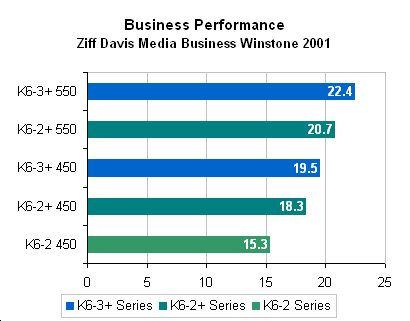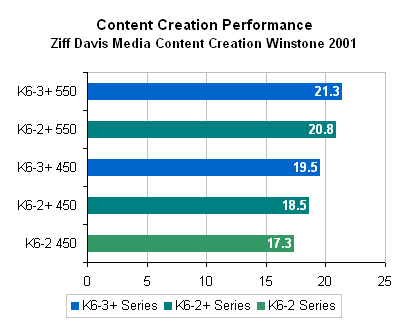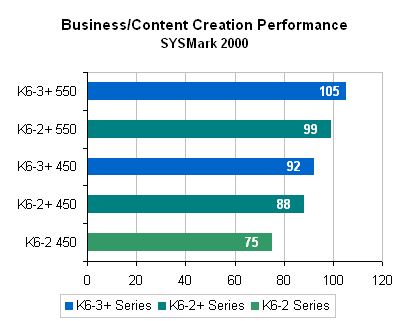Super7 Upgrade Guide: The K6-2+ and K6-3+ Processors
by Matthew Witheiler on January 24, 2001 1:16 AM EST- Posted in
- CPUs
Business/Content Creation Application Performance - Win2K

Rather than start looking at the above graph by looking at the top performer, let's take a look at what falls to the bottom when it comes to performance. The K6-2 450MHz, not surprisingly, is the slowest of the processors tested. What is surprising, however, is the fact that the K6-2 450MHz looses by such a large degree. The chip looses to it's K6-2+ 450MHz brother by a full 20% and is beat by the K6-3+ 450MHz by 27%.
This shows how much of a difference the addition of L2 cache can make. The jump to 128KB L2 cache that was added to the K6-2+ core alone provided the full 20% speed difference. The clock speeds are the same, the chip design is identical, with the only difference coming with the on-die L2 cache. Keep in mind that the K6-2 used for testing actually "saw" 2MB of cache, the problem is that the cache was located off the chip and therefore had to be sent information via the system's 100MHz front side bus. The additional 128KB of cache that the K6-3+ has over the K6-2+ allowed this chip to take a slight lead, performing 7% faster than the K6-2+ chip. Not quite the improvement we saw going from no cache to 128KB, but still not too bad.
Not surprisingly, the K6-3+'s 256KB of L2 cache running at 450MHz does not make up for the 100MHz speed difference between it and the K6-2+ at 550MHz. This goes to show that regardless of cache size, clock speed remains the most important factor in K6-2+ and K6-3+ processor selection
Topping the graph are the K6-2+ and K6-3+ running at 550MHz. The K6-3+ is able to edge out the K6-2+ by 8%, a modest improvement along the lines of what we saw between the two chips at the 450MHz speed limit. The top performing K6-3+ at 550MHz is able to out perform the older K6-2 at 450MHz by 46% in Business Winstone 2001; quite a speedy upgrade.

In Ziff Davis Media's Content Creation Winstone 2001 benchmark, the results are eerily similar to what was found in Business Winstone 2001. At the finish line, all processors tested come in at the same places as before, a trend that will only continue as the benchmarking goes on.
Once again, the addition of 128KB L2 cache to the K6-2+ core provides for a 7% speed improvement over the L2 cache-less K6-2 at the same speed. The K6-3+'s 256KB of L2 cache provided for a 5% speed increase over the K6-2+ chip. You may notice that the speed differences between the chips are less than what we saw in Business Winstone 2001. This is most likely due to the fact that Content Creation Winstone 2001 uses highly intensive applications, unlike the less intensive Business Winstone 2001. Since the benchmark is based on very power hungry applications, more factors of a system come into play, including the memory bandwidth (which stays constant since the same motherboard was used for all testing) as well as hard drive performance (also a constant).
The top two performers remain the chips clocked at 550MHz. The K6-3+ with its 128KB cache lead is able to outperform the K6-2+ by a mere 2%.

Our final business/content creation benchmark, SYSMark 2000, shows quite a liking for on-die L2 cache, providing the K6-2+ with a 17% performance lead over the same speed K6-2 chip. The K6-3+, with its 256KB on-die L2 cache, was able to provide a 5% speed boost over the 128KB K6-2+.
The 550MHz chips performed within 6% of each other, with the K6-3+ running on top as usual.










1 Comments
View All Comments
Leper Messiah - Tuesday, November 21, 2006 - link
^_^